10 Best Famous Foods to Eat in Oaxaca City | What is Oaxaca City known for food

- By
- Aparna Patel
- |
- 1 May, 2023
- |

Welcome to our foodie’s guide to Oaxaca City, Mexico! Oaxaca is a vibrant and colorful city that is known for its rich culture, beautiful architecture, and delicious food. Oaxacan cuisine is a unique blend of indigenous ingredients and Spanish influences, resulting in a diverse and flavorful culinary experience.
In this article, we will explore the 10 best famous foods to eat in Oaxaca City, from savory tlayudas to sweet and spicy chocolate. Whether you’re a food lover or simply looking to explore the local cuisine, this guide will help you discover the best Oaxacan dishes and where to find them.
What is Oaxaca City famous for food
1.Tlayudas
A large, crispy tortilla topped with refried beans, cheese, meat (usually beef or pork), and a variety of toppings like avocado, tomato, and salsa.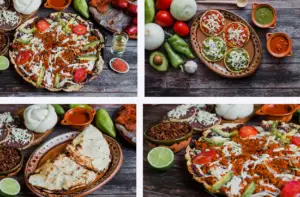
Tlayudas are a popular street food in Oaxaca City, Mexico. They are a type of large, crispy tortilla that is typically topped with refried beans, Oaxaca cheese, avocado, lettuce, and meat (such as chorizo, tasajo, or cecina).
The tortilla used for tlayudas is usually made from corn and is prepared by heating it on a comal, a flat griddle used in Mexican cuisine. The toppings are then added and the tlayuda is folded in half and served hot.
Tlayudas are a delicious and filling food that can be found in many places throughout Oaxaca City. They are especially popular at night, when vendors set up stalls on the streets to sell them to hungry locals and tourists.
Some of the best places to try tlayudas in Oaxaca City include the Mercado 20 de Noviembre, where you can find a wide variety of toppings to choose from, as well as La Tlayudería, a popular restaurant that specializes in tlayudas and other traditional Oaxacan dishes.
2.Mole Negro
A complex and rich sauce made with chili peppers, chocolate, spices, and sometimes nuts or seeds. It’s often served over chicken or turkey.

Mole Negro is a famous traditional dish from Oaxaca City, Mexico. It is a rich and complex sauce made from over 20 ingredients, including chili peppers, spices, nuts, seeds, and chocolate.
The name “Mole Negro” literally means “black mole,” which refers to the dark color of the sauce. It is typically served over chicken or turkey and is a staple dish for special occasions and celebrations.
To make Mole Negro, the ingredients are first toasted and then ground into a paste. The paste is then cooked with broth until it thickens into a sauce. The process of making Mole Negro can be time-consuming and requires a lot of skill, which is why it is often reserved for special occasions.
Mole Negro is a delicious and unique dish that is definitely worth trying if you are in Oaxaca City. It can be found in many restaurants and street food stalls throughout the city, but some of the best places to try it include the Mercado de la Merced, El Tule Restaurant, and Los Danzantes.
- Best Famous Foods to Eat in San Miguel de Allende City
- Best Famous Foods To Eat In Cancun, City
- Best Things Cancun City is Famous For
3.Chapulines
Roasted grasshoppers seasoned with salt, chili, and lime. They’re a popular snack in Oaxaca and can be found at local markets and street food stalls.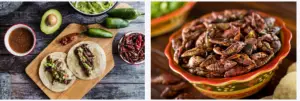
Chapulines are a type of grasshopper that is commonly eaten in Oaxaca City, Mexico. They are often served as a snack or added to dishes as a crunchy, protein-rich topping.
If you are interested in trying chapulines, you can find them in many markets and street food stalls throughout the city. They are typically seasoned with salt, chili powder, and lime juice to enhance their flavor.
Before eating chapulines, it is important to ensure that they are cooked properly to avoid any potential health risks. They should be thoroughly cleaned and roasted or fried until crispy.
While eating insects may seem unusual to some people, it is a common practice in many cultures around the world and is considered a nutritious and sustainable source of protein. So if you’re feeling adventurous, give chapulines a try during your visit to Oaxaca City!
4.Enchiladas Oaxaqueñas
Tortillas filled with chicken or beef and covered in a rich red or black mole sauce, topped with cheese and onion.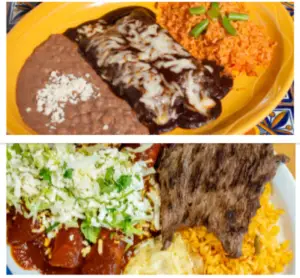
Enchiladas Oaxaqueñas are a delicious and popular dish in Oaxaca City, Mexico. They are made with corn tortillas that are filled with shredded chicken, cheese, and sometimes vegetables like potatoes or carrots. The tortillas are then rolled up and covered in a rich and flavorful sauce made from chili peppers, garlic, and other spices.
The sauce used for Enchiladas Oaxaqueñas is what sets them apart from other types of enchiladas. It is a dark and slightly sweet sauce made with a special type of chili pepper called chile pasilla Oaxaqueño, as well as other ingredients like tomatoes, cinnamon, and chocolate. The sauce is cooked until it thickens and the flavors meld together, resulting in a delicious and complex flavor.
Enchiladas Oaxaqueñas are typically served with a side of rice and beans, as well as toppings like lettuce, avocado, and queso fresco. They can be found in many restaurants throughout Oaxaca City, but some of the best places to try them include La Olla Restaurant, Los Pacos Restaurant, and El Topil Restaurant.
If you are a fan of enchiladas, Enchiladas Oaxaqueñas are definitely worth trying during your visit to Oaxaca City.
5.Memelas
Small, thick tortillas topped with beans, cheese, and salsa. They’re often served as a breakfast food.
They are similar to tostadas, but smaller and thicker. Memelas are made from masa, a dough made from corn that is flattened into a disk and cooked on a griddle.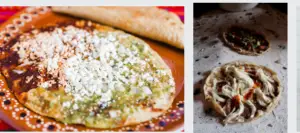
Once cooked, the memelas are topped with refried beans, cheese, and a variety of other toppings such as salsa, avocado, and shredded meat. Some versions may also include chapulines (grasshoppers), which are a popular Oaxacan ingredient.
Memelas are a simple and affordable snack food that can be found in many markets and street food stalls throughout Oaxaca City. They are often eaten for breakfast or as a midday snack, and are a popular option for people on the go.
If you’re looking to try memelas, some of the best places to do so include the Mercado de la Merced, the Mercado 20 de Noviembre, and the Mercado Benito Juarez. These markets have numerous vendors selling memelas with a variety of toppings, so you can choose your favorite and enjoy this delicious Oaxacan snack.
6.Tamales Oaxaqueños
Similar to traditional tamales, but with a unique filling made with a blend of mole sauce and chicken or pork.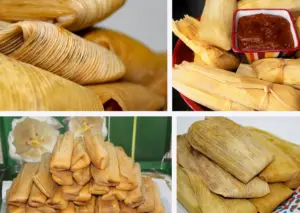
Tamales Oaxaqueños are a traditional dish from Oaxaca City, Mexico, and are a must-try when visiting the region. They are made from masa, a dough made from corn that is filled with a variety of ingredients such as meat, vegetables, and cheese. The mixture is then wrapped in a corn husk and steamed until cooked.
The filling of Tamales Oaxaqueños can vary depending on the region and the cook. Some common fillings include chicken or pork in a spicy red or green sauce, black beans, and cheese with a spicy salsa. They are often served with a side of salsa or guacamole.
Tamales Oaxaqueños can be found in many restaurants and street food stalls throughout Oaxaca City, but some of the best places to try them include the Mercado de la Merced and the Mercado Benito Juarez. These markets have numerous vendors selling tamales with a variety of fillings, so you can choose your favorite and enjoy this delicious Oaxacan dish.
If you’re feeling adventurous, you can also try Tamales de Chapulines, which are tamales made with grasshoppers. They are a unique and flavorful twist on the traditional tamale and are a popular delicacy in Oaxaca City.
7.Tejate
A traditional pre-Hispanic beverage made from maize, cacao, and the flower of the mamey fruit. It’s a refreshing and slightly sweet drink that’s often served with a foam on top.

Tejate is a traditional beverage from Oaxaca City, Mexico, that has been enjoyed for centuries. It is made from a blend of toasted corn masa, cacao beans, mamey fruit seeds, and the dried flowers of the Rosita de Cacao plant. These ingredients are ground together and mixed with water to create a thick and frothy drink.
Tejate is a refreshing and flavorful beverage that is perfect for hot Oaxacan days. It has a nutty and slightly sweet flavor, and the texture is similar to a milkshake. It is often served in a gourd bowl and is traditionally enjoyed with a straw made from a hollowed-out flower stem.
Tejate is a unique and cultural experience that can be found in many markets and street food stalls throughout Oaxaca City. It is a must-try when visiting the region and is a favorite among locals and tourists alike.
8.Quesillo
A type of string cheese made in Oaxaca. It’s often used as a topping for tlayudas and other dishes.

Quesillo is a type of string cheese that is a staple of Oaxacan cuisine. It is made from cow’s milk and has a soft, slightly elastic texture that makes it perfect for melting. Quesillo is used in many traditional Oaxacan dishes such as tlayudas, quesadillas, and enchiladas.
If you’re looking to try quesillo on its own, it can be found in many markets and street food stalls throughout Oaxaca City. It is often served with tortillas and a spicy salsa or alongside other Oaxacan snacks like memelas or tlayudas.
For a more upscale dining experience, many restaurants in Oaxaca City also offer dishes featuring quesillo. Some popular options include quesillo stuffed with mushrooms or chorizo, quesillo and squash blossom soup, and tlayudas topped with quesillo and other traditional Oaxacan ingredients.
9.Caldo de Piedra
A traditional soup made with fish, vegetables, and herbs that’s cooked by placing hot rocks into a bowl of water and ingredients.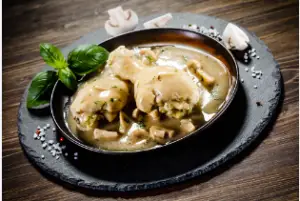
Caldo de Piedra, which translates to “stone soup,” is a traditional dish from the Zapotec culture in Oaxaca City, Mexico. The dish is named after the unique cooking method, which involves heating stones in a fire until they are hot and then using them to cook the soup.
To make Caldo de Piedra, a soup base is prepared using fish, tomato, onion, and cilantro. The hot stones are then placed in a bowl along with the fish, and the soup base is poured over them. The heat from the stones cooks the fish, and the soup is served hot with tortillas and lime wedges.
Caldo de Piedra is a flavorful and unique dish that is not widely available in restaurants, as it is typically prepared only in the homes of the Zapotec people. However, there are a few places in and around Oaxaca City where you can try it, including the village of San Felipe Usila in the Sierra Norte mountains and the El Sabor Zapoteco restaurant in the town of Teotitlan del Valle.
If you’re interested in trying Caldo de Piedra, it’s best to plan ahead and make arrangements to visit one of these locations. The dish is a cultural experience as much as a culinary one, and trying it is a great way to learn more about the history and traditions of the Zapotec people.
10.Chocolate Oaxaqueño
Oaxaca is known for its high-quality chocolate made from cacao beans grown in the region. It’s often used in mole sauces and other traditional dishes.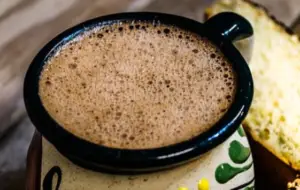
Chocolate has been an important part of Oaxacan culture for thousands of years, with the ancient Zapotec and Mixtec civilizations using cacao beans as currency and in ceremonial offerings.
Oaxacan chocolate is typically made by grinding roasted cacao beans with sugar, cinnamon, almonds, and other spices, such as vanilla, allspice, or chili. The resulting paste is then used to make a variety of chocolate products, including bars, hot chocolate, and mole sauce.
One of the best places to try Oaxacan chocolate in Oaxaca City is at the Mercado de la Merced, where there are several stalls that sell freshly made chocolate in a variety of forms. You can also find artisanal chocolate shops throughout the city, such as Mayordomo and La Soledad, which offer a range of chocolate products made using traditional methods.
When visiting Oaxaca, be sure to try a cup of hot chocolate made with Oaxacan chocolate. It is often served with a foam on top and can be sweetened to taste. Another popular way to enjoy Oaxacan chocolate is in mole sauce, which is a complex blend of spices and chocolate used to flavor dishes like enchiladas and tamales.
Overall, Oaxacan chocolate is a delicious and unique culinary experience that is not to be missed when visiting Oaxaca City.
These are just a few of the delicious local foods that you should try when you visit Oaxaca City. Make sure to also try some of the many mezcal varieties produced in the region, and explore the local markets to discover even more culinary delights.
Search Posts
Latest posts
-
5 Mar, 2024
Passing through airport security with autism
-
4 Mar, 2024
How can I do a "broad" search for flights?